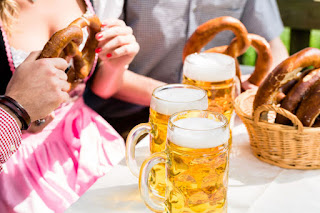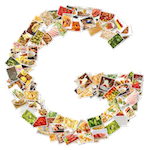To understand the differences, we must take a look at their histories and cultures, which play an important role in how beer is produced in each of these two countries.
A Brief History of German Beer
The German beer industry is well known for operating under the 500-year old Reinheitsgebot; a beer purity law put into effect in 1516. The original law was enacted as a means of quality control and a way to standardize the product and pricing of the grain used for brewing. It allowed only barley, hops, and water as the ingredients in making beer. |
| Beer and Pretzel |
A Brief History of Belgian Beer
Like Germany, Belgium has a beer-making tradition that goes back centuries. Before becoming a sovereign kingdom in 1831, the small nation was ruled by Austria, France, and the Netherlands at different points during its history. |
| Abbey in Orval Belgium |
The Trappist monks also helped spur innovation, and they continue to produce the most sought-after Belgian beers.
German Beer
Ask any German brewer about their beer and the response would most likely be "We make the best lagers or wheat beers". This is probably an accurate answer as the Germans are known for their high quality beer which strictly follows the long-standing beer purity law and is made using traditional methods. However you are unlikely to find a large variation in styles of beer in Germany.Popular Types of German Beer
Pilsner - This pale lager is the most popular type of German beer.Hefeweizen - The most common German wheat beer, known for a cloudy appearance due to the special yeast used in brewing.
Marzen or Oktoberfest - This classic Bavarian lager is the darkest beer with a relatively low alcohol content.
Kölsch - This beer is fermented at cooler temperatures than other styles and has a hoppy and somewhat fruity flavor. The name is protected under European Union regulations and can only be used by breweries in the Cologne region.
Belgium Beer
The culture and philosophy of beer making in Belgium is entirely different as compared to Germany. They use a variety of ingredients, besides the 4 key ingredients, creating their own styles and flavor.You will find many different styles and flavors of beer in Belgium as the brewers compete with each other to create their own unique style of beer.
Popular Types of Belgian Beer
Dubbel - A Trappist ale made in a monastery, which gets its reddish-brown deep color from caramelized beet sugar.Quadrupel - Simiar to the dubbel but with more flavor and higher alcohol content.
Tripel - A golden ale similar to the dubbel but brewed with beet sugar that hasn't been caramelized.
Saison - A pale, citrusy, hoppy 'farmhouse' ale with high carbonation levels.
Witbier - A crisp beer made from unmalted wheat, coriander and orange peel.
Article Category: Drinks & Culture




No comments